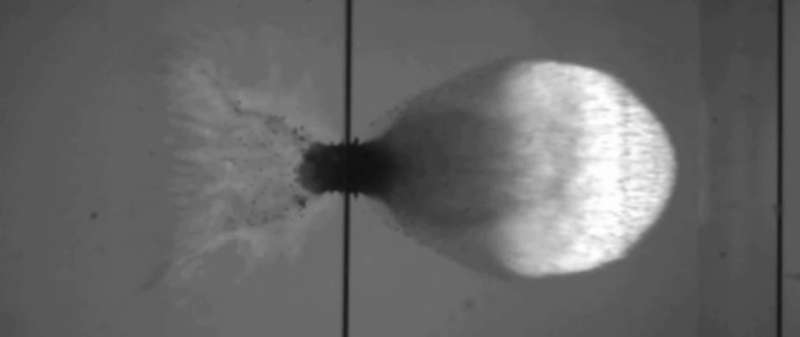Image: Hypervelocity impact testing

What looks like a mushroom cloud turned sideways is actually the instant an 2.8 mm-diameter aluminium bullet moving at 7 km/s pierces a spacecraft shield, captured by a high-speed camera.
"We used a gas gun at Germany's Fraunhofer Institute for High-Speed Dynamics to test a novel material being considered for shielding spacecraft against space debris," explains ESA researcher Benoit Bonvoisin.
"Our project has been looking into various kinds of 'fibre metal laminates' produced for us by GTM Structures, which are several thin metal layers bonded together with composite material."
Growing levels of orbital debris pose increasing risks to all kinds of Earth-orbiting missions, adds engineer Andreas Tesch: "Such debris can be very damaging because of their high impact speeds of multiple kilometres per second.
"Larger pieces of debris can at least be tracked so that large spacecraft such as the International Space Station can move out of the way, but pieces smaller than 1 cm are hard to spot using radar – and smaller satellites have in general fewer opportunities to avoid collision."
In some orbital regions small natural meteoroids can also pose a threat, in particular during intense seasonal meteoroid streams such as the Leonids.
To avoid damage from whatever source, protection is needed against small debris, typically consisting of one or more shields. Often used is the 'Whipple shield' – originally devised to guard against comet dust – with multiple layers separated by 10–30 cm.
The project, supported through ESA's General Support Technology Programme, which prepares promising technology for spaceflight, looked at the efficiency of fibre metal laminates compared to current aluminium shields.
This still from the video shows the point after which the solid aluminium bullet has broken apart into a cloud of fragments and vapour, which becomes easier for the following layers to capture or deflect.
"The next step would be to perform in-orbit demonstration in a CubeSat, to assess the efficiency of these FMLs in the orbital environment," concludes Benoit.
Provided by European Space Agency




















